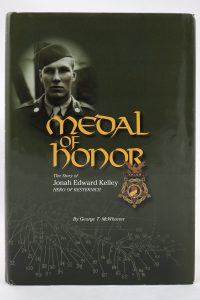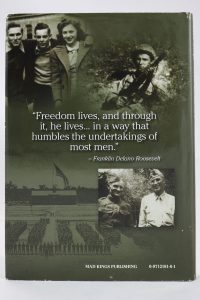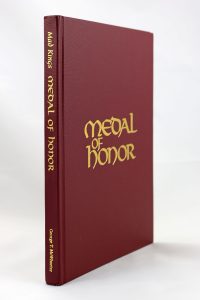- Home
- Biography
- Medal of Honor
- Honors
- Ed Kelley Memorial Plaza
- J. Edward Kelley Society
- Jonah E. Kelley Army Reserve Center
- Jonah E. Kelley Memorial Bridge
- Jonah Edward Kelley Day
- Kelley Barracks, US Army Base
- Kelley National Guard Armory
- Medal of Honor Book
- Medal of Honor Grove
- USAT Sgt. Jonah E. Kelley
- USNS Sgt. Jonah E. Kelley
- 78th Lightning Division Memorial
- Ed’s Journey to WWII
- Galleries
- Family
- Contact
Jonah Edward Kelley
Medal of Honor Recipient
Medal of Honor Book

“Medal of Honor”
by
George T. McWhorter
(Mad Kings Publishing)
(Reviewed by John Martin)
George T. McWhorter had it in mind to write a story about those who had won the Medal of Honor, the nation’s highest military decoration for valor above and beyond the call of duty.
He at first planned “an ‘unknown soldier’ motif for the book.” But as he scanned the records, he began to realize that it would be better “to present an in-depth study of valor through the exploits of a single man than to attempt a book on valor from a cross sampling of our honored dead.”
He did not at first zero in on Jonah Edward Kelley of Keyser, West Virginia. Rather, “Kelley picked me” when “I saw Kelley’s impish grin in a photograph,” wrote McWhorter.
From there, McWhorter began to do research to find family and friends of this World War II Army “Hero of Kesternich,” and his efforts resulted in the publication of the book earlier this year.
McWhorter dedicated the book to all of the men who fought in World War II.
The author relates the family background of Ed and then, through facts gleaned from interviews with family and friends, and supplemented by photos, tells the story of a young man who grew up in in the small mountain town of Keyser, population today nearing 5,500, a town labeled as “The Friendliest City in the U.S.A.”
Ed was a normal boy, growing up with a zest for adventure and knowledge, and along the way he acquired leadership skills. In fact, the reader will surely smile in reading Chapters 3, 4 and 5, which recount the numerous youthful activities of Ed and his friends, in a day when young people had no video games or texting devices to occupy their time but had to come up with games and pastimes using only the resources provided to them by friends and the local environment.
“As his character developed, his classmates came to look on him as a natural leader whose principles of conduct could not be compromised in any situation. At the proper moment, a look or a gesture form Ed could be worth a thousand profanities. His good nature was uncluttered by grudges or recriminations, while trust in his parents’ judgment solidified his own emergeing values.”
McWhorter wrote further, “By the time he had reached his teens, Ed’s reputation for honesty had become proverbial, and Lester Gates recalls that if he owed a penny he’d walk a mile to repay it.”
After the Japanese bombed Pearl Harbor, everyone wanted to join the service. Ed was determined to join the Marines but they turned him down, claiming he was color blind. A year later he was able to take an Army physical which found no such difficulty, and he was soon on his way to training and, eventually, deployment.
Ed was one of those assigned to the newly reactivated 78th Lightning Division and rose steadily through the ranks until he was a staff sergeant by the time of the battle of Kesternich in Germany, where he won the Medal of Honor and lost his life.
Kesternich itself was a small town in Germany near its border with Belgium, but its location was strategic and it needed to be taken in order for allied troops to advance. An earlier attack had failed to rout the German defenders. This time, it was the Lightning Division’s turn to try.
Kesternich was a much smaller town than Keyser, having only 112 buildings in it. But those buildings had been taken over by German forces and Ed’s outfit had to clean them out, building by building.
On Jan. 30, 1945, Ed had already been wounded — in his back and his left hand. Instead of retreating to a medical station, he put a rough bandage on the shattered hand and used his rifle with only his right hand, “resting it upon rubble or over his left forearm.” When it was necessary to toss hand grenades, he’d put his rifle down and pull the grenade pin with his teeth.
He did all that because of his sense of responsibility for the men under his command. Instead of ordering them forward, he preceded them, rushing one house and killing three enemy soldiers, clearing the way for his squad to advance. He then killed a sniper and another charging enemy soldier. The next morning, he left his squad in a safe location and advanced to kill an enemy gunner dug in under a haystack. Once again finding his squad unable to advance due to a machine gun nest, he ordered them to remain in a safer position and attacked the gun single-handed, being brought to his knees in a hail of fire. Before he died, he shot dead all three of the machine gunners.
The book contains a whole chapter with a detailed after-action report by Col. Richard W. Keyes, a battaliion commander with the Lightning Division’s 311th Infantry, placing Ed’s courageous actions in context of the overall battle.
“Medal of Honor” is a solemn and worthy tribute to what one motivated and courageous U.S. soldier can do, and Ed’s actions are typical of all of those who have won the nation’s highest honor, and of many other brave men who have won other decorations or none at all.
The book, hardbound with a dust jacket, cannot be purchased on websites such as amazon.com. After sending copies of the book out to various people, McWhorter then donated the entire remaining stock to Keyser High School to be sold as a fund-raiser for the school.
According to Charles Wimer, principal, copies of the book may be purchased by mailing a check or money order for $10, which includes shipping to:
Attn: Medal of Honor book
Keyser High School
One Tornado Way
Keyser, WV 26726
Source: http://www.erbzine.com/george/



